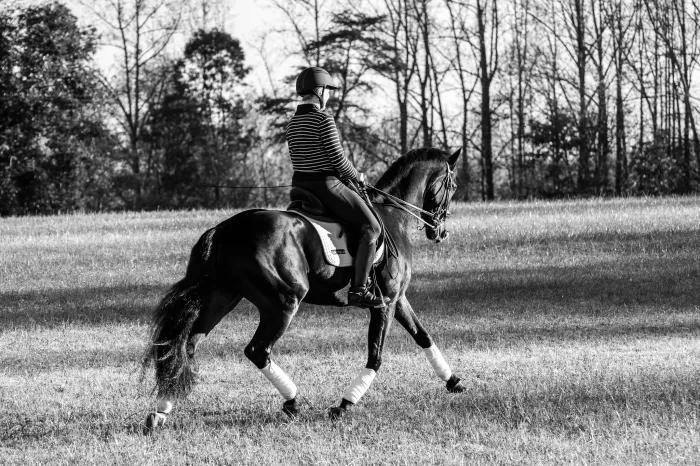I’ve made many FEI dressage horses, most of them out of horses who were complete and utter ding-dongs as children but reformed enough by middle age to be able to do the top-level work on a combination of training and adrenaline. I’ve never really had to think about horse fitness before. But Elvis and Helio are really pleasant, agreeable fellows. They’re not nutty. And they’re not hot. So with Elvis’ Grand Prix debut, and Helio’s rapid approach to that level, I’ve realized that I need a lot more gas in their collective tanks to execute that level of work, with aplomb, and on a hot competition Sunday.
And I realized I don’t know how to do that. So I fumbled along for a while, and then I got some help from one of the best in the world.
Allow me to explain.
First, let’s talk about what all three boys’ daily plan has looked like up until this spring. Puck (one of the aforementioned reformed wingnuts), Elvis and Helio work five days a week, Tuesday through Saturday, usually in either my indoor or outdoor arenas, though occasionally on nice days we’ll play in the fields, too. My farm here in Virginia is 85 acres of green, rolling hills, so there’s plenty of muscle-building terrain. But more on that in a moment.

Conditioning Elvis for peak FEI performance has been about slow and steady (and up and down hills). Heather Richards Photo.
Until 2019 for Elvis and 2020 for Puck and Helio, my horses really needed to spend time working in the ring to learn the technique of the Fédération Equestre Internationale levels. They needed to learn how to bend and how to half-pass; how to piaffe and do flying changes. Of course you can do those things in the field, but I’m a spoiled rotten thing with fancy footing and gorgeous mirrors, and so I tend to do more of my work where I have the mirrors for feedback and can focus on the training instead of the terrain.
Now these boys are pretty broke to the work at the levels that they’re competing. So, since we came home from Florida, I’ve been trying to ride them for 45 minutes each. On days when one feels like pool noodle, that time might be filled more with stretching and hacking, and less with actual capital-W Work, but I ride the clock and not the horse to start thinking about expanding the muscular capacity of each. That’s just not enough, especially for horses like Elvis and Helio, who aren’t energetic lunatics by nature. For Elvis in particular, I knew that to make the push to being a really big-time international Grand Prix horse, I’d have to do more.
I knew I needed to add in fitness work beyond normal ringwork, so when I got back to Virginia, Elvis started walking more. We began with three days a week in our exerciser machine, 20 minutes the first week, then 30 minutes the second. Then I put a human on his back, and we did hills at the walk three days a week, 20 minutes the first week, 30 minutes the second. That got us to the show we did earlier this month, where Elvis had a normal week, no extra walking; a “taper” week, in the lingo of human endurance training. It paid off with Elvis’ break into the 70s at his first National Championship qualifier. So far, so good. But what to do next?
Enter Jimmy Wofford.
ADVERTISEMENT
I knew upper-level event riders do trot sets, but I had some concerns. My horses are heavier than event horses, carrying much more muscular bulk, and I was afraid of the extra wear and tear that trot or gallop sets would do, particularly at Elvis’ mass. So I called Mr. Wofford, who is not only an exceptionally accomplished horseman but also a real scholar, and I’ve always loved his articulate and wise thoughts on a variety of subjects, horsey and not.
He said this: It’s pick-and-shovel work, Lauren. Walk, walk, walk.
Trot sets are too high a risk for too low a reward, he said. When he was still competing, he said, his five-star horses would walk for two hours a day. “It’s really hard to do a soft tissue injury at the walk on good footing,” he told me. And because we live in Virginia, hills are another layer of magic.
So that’s been the plan, increasing the time, and then the days of the week. The week after the show, I did another week of three walk sets at 30 minutes, and the following I did four at 30. And, by the way, we do all of this walking in an Equiband system, which allows for Elvis to have a reminder about engagement without his rider needing to touch his mouth or use their seat and leg. It means my greenest working students can be productive if they’re the ones to do his walking. (Because I’m a pretty busy teacher and rider right now!)
Helio has started a similar program and already is showing me more capacity. Puck, meanwhile, has gotten markedly fitter just from working 45 minutes a day, to the point where he now basically vibrates while being groomed and tacked. (Oh, goodie.)
For Elvis, this program has been magnificently transformative. He was fresh as a daisy after we got back from the show and not even a little sore. And we’ve only just begun!
Lauren Sprieser is a USDF gold, silver and bronze medalist making horses and riders to FEI from her farm in Marshall, Virginia. She’s currently developing The Elvis Syndicate’s Guernsey Elvis and her own string of young horses with hopes of one day representing the United States in team competition. Read more about her at SprieserSporthorse.com, or follow Lauren Sprieser on Facebook and Instagram.














